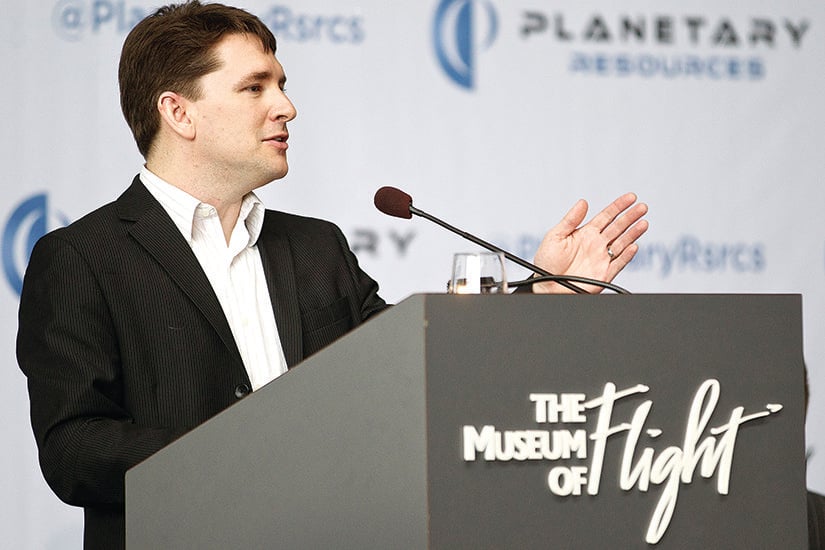Planetary Resources, founded by X Prize creator Peter Diamandis in 2009, is a Seattle-based startup that’s focused on developing technology to mine asteroids. In the past year, the company has hit several milestones: A new law allows for the legal ownership of asteroids, and Planetary Resources proved that objects can be 3D printed from the same kind of materials found on asteroids. And in May the company announced it had secured $21 million financing for its Ceres project, which is focused on developing orbital platforms for monitoring the earth. Worth caught up with CEO Chris Lewicki, a veteran of NASA’s Spirit and Opportunity missions to Mars, to discuss the future of the commercial space industry.
IN CONCRETE TERMS, WHAT IS PLANETARY RESOURCES DOING RIGHT NOW?
Our vision, in brief, is to expand the economic sphere of humanity through the pursuit of and development of resources in space. We’re working on sensor systems to better monitor and manage resources on Earth, and we’re developing them to identify, locate and ultimately manage resources in space.

RIGHT NOW YOU’RE ESSENTIALLY DOING EARTH MONITORING AS A BETA TEST. BUT THE GOAL IS TO EVENTUALLY MAKE CONTACT WITH A NEAR-EARTH ASTEROID.
We’re using Earth’s orbit as our test bed. It’s been more convenient to orbit the Earth than it ever has been in history. Near-Earth asteroids in particular are our interest because they often do actually come closer to the Earth than the moon. But more importantly is that when you look at the amount of energy required to travel to anywhere in space beyond low-Earth orbit, you’ll find that over 4,000 of these so-called near-Earth asteroids are actually easier destinations to get to and certainly come back from than landing on the surface of our own moon.
SO WHEN WE TALK ABOUT MINING AN ASTEROID, WHAT DOES IT MEAN? DRAGGING IT INTO EARTH ORBIT, OR BRINGING IT BACK IN PIECES TO EXTRACT RARE EARTH MINERALS FOR TERRESTRIAL MANUFACTURING?
There are three broad categories of resources that you could classify asteroids into. The first is probably what grabs all the headlines in terms of very valuable and very rare, but very usable, platinum group metals. There are a lot of different theories on extracting that, but it’s certainly a difficult and challenging thing that I see as something happening at the perfection of the industry.
Leading up to that is the extraction and development of structural metals, things like iron and nickel and stainless steel. Things that you could use for in-space manufacturing (ISM). We actually demonstrated… back in January, that you can take material directly from an asteroid—in this case in the form of an iron meteorite—put it in to a 3D printer and print structures. Now imagine having the capability to just send the printer and be able to create structures that never need to fold up and go in a rocket, never need to experience Earth’s gravity or the acceleration of getting into space. So that is something certainly we see as transformative.

RIGHT. ISM AND VALUABLE MINERALS ARE TWO OF THE FOCUSES. WHAT’S THE THIRD?
It all begins with a very simple thing that you don’t often think of as a resource, but in space it’s very rare, very precious. And that’s the water molecule. Water has a lot of obvious uses; humans are, of course, mostly made of the stuff, and it helps us grow the flora and fauna that’s necessary for everything around us. But we also take it for granted as an industrial solvent. In space, it takes on two unique uses. The first is protecting you from the galactic toxic radiation and radiation you might get from solar flares if you’re traveling from point A to point B in space. This is a big technological problem for which NASA is exploring solutions in long duration space travel. A coating or a blanket of water can actually provide the same type of protection that the Earth’s atmosphere provides. But it costs hundreds of millions of not billions of dollars, just in transportation costs, to ship that much water up and then to hold it.
But what’s really exciting is [that] hydrogen and oxygen are the same elements that fueled all 135 of the space shuttle launches. It has to be the most efficient and the best chemical reaction on the periodic table of the elements for creating high-thrust propulsion.
SO YOU’RE TALKING ABOUT MAKING ROCKET FUEL IN SPACE.
Imagine being able to go into space and instead of throwing away the rocket when it’s empty or having to build something to take with you, [you already have] all the fuel that you’ll ever need—being able to cozy up to a space fuel depot and top off your tanks. Maybe you bring the fuel with you from the surface of the Earth or the surface of Mars. Maybe at first you’ll just grab oxygen and liquid oxygen and use that as oxidizer. Of course, you can fuel up your spaceship, and you can fill up your oxygen tanks for the astronauts.
What we anticipate being able to do is rendezvousing with the asteroid out in space—right where it sits orbiting the sun—and instead of bringing the mountain to the refinery, so to speak, you do what you do right here on Earth in traditional mining, which is doing a lot of [the processing] and the purification right at the site. In some cases you might be able to get to 100 percent pure, in other cases you’ll just reduce it down to something more suitable to a final process as it gets close to the Earth.
THAT MAKES SENSE FOR METALS AND CONSTRUCTIVE MATERIALS, BUT HOW DOES THAT PLAY OUT WITH WATER?
With water, I think we have the opportunity to come close to that 100 percent efficiency. If you’re out at sea and you need to make fresh water to drink, you can create something that collects the heat of the sun and use that to [create steam]. That steam water evaporates and forms water vapor, and then it hits a cooled surface and condenses out as pure water.
In space, you have all of the parts of that thermodynamic environment. The heat from the sun, 24 hours a day, is available for free. This is a perfect industrial vacuum that you don’t need any machine to create, that allows you to efficiently transfer this water vapor. Then everything in space that is not in the sun is very, very cold. So you have the ability to create a cryogenically cooled surface to condense out ice from this water vapor… The refrigeration plant comes for free.
IS THE THEORY THAT YOU CAN SEND 3D PRINTERS DIRECTLY TO AN ASTEROID AND BUILD A FUELING DEPOT, FOR INSTANCE?
Absolutely. It’s like having the local town blacksmith along with you in a settler town in the early Americas. The same type of [asteroid] that you would probably get the water from, has mixed in it already some micro-particles of iron and iridium that you might use in that 3D printer. You may not even need a complex process to create the printer ink, so to speak, because it literally comes out of the waste stream of creating water.
It’s a way of thinking about establishing a foothold and a permanent presence in space. It’s in a new environment, to be sure, but this is just the latest form of what technology allows to expand humanity and to become a multiplanetary species.
IN NOVEMBER, THE PRESIDENT SIGNED THE U.S. COMMERCIAL SPACE LAUNCH COMPETITIVENESS ACT INTO LAW, WHICH ALLOWS FOR THE COMMERCIAL OWNERSHIP OF ASTEROIDS. WAS PLANETARY RESOURCES INVOLVED IN LOBBYING FOR THIS?
We were certainly supporting the Congressmen and Senators who brought this idea forward, and that establishes a framework that this is an industry that the U.S. sees as important to the country’s future. When we go out to an asteroid to extract that first water, there will be no question that the water that we were able to extract from the asteroid is our property. We can keep it. We can use it. We can sell it. We can use this framework as the foundation on which to create all the additional laws and regulations that will develop over time.
This helps give our business, our investors and our future customers the assurance that we’ll be backed by entities like the United States government. We’ve seen other countries somewhat follow suit in their interests in promoting this environment, like the United Arabs Emirates, which is developing its own space policy as it grows its space program.
THIS ISN’T JUST AMERICAN COMPANIES, THEN. IT’S REALLY A GLOBAL PUSH. HOW IMPORTANT WILL THIS BE IN A HISTORICAL SENSE?
This is quite possibly the next biggest industry in the global economy. That sounds like hyperbole, but think about the mining prospects in the 1800s and 1900s that really helped establish our industrialized society, and then in the 20th century energy and oil and gas projects are measured not in the millions, not in the billions, but in tens of billions of dollars. And you think about how central oil is to our economy today. What we are speaking about in space is that central and that pivotal. There’s no limit to its scale because the sky—literally—is no longer the limit.
The oil industry didn’t develop overnight, but it very quickly went from creating lamp oil to replace whale blubber in the late 19th and early 20th century, to being something that was a strategic interest to the biggest military forces in industrialized societies in the world. If humanity is going to explore space, and if we are going to make it our economic environment as we have done everywhere on Earth, this is one of the biggest economic opportunities ever. Our company and probably hundreds like us will all be working towards what will be a multitrillion dollar part of the economy.
For more information, visit planetaryresources.com










